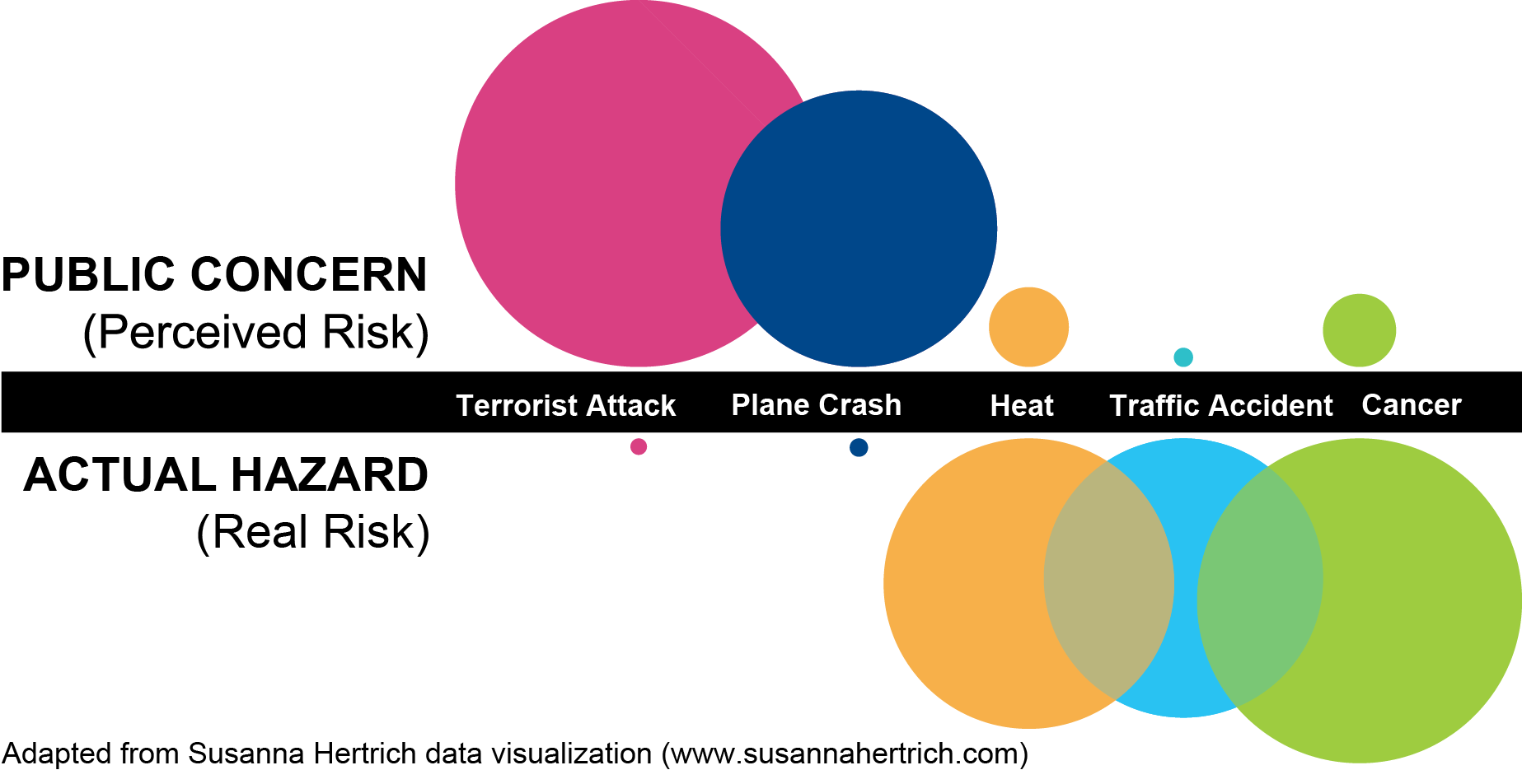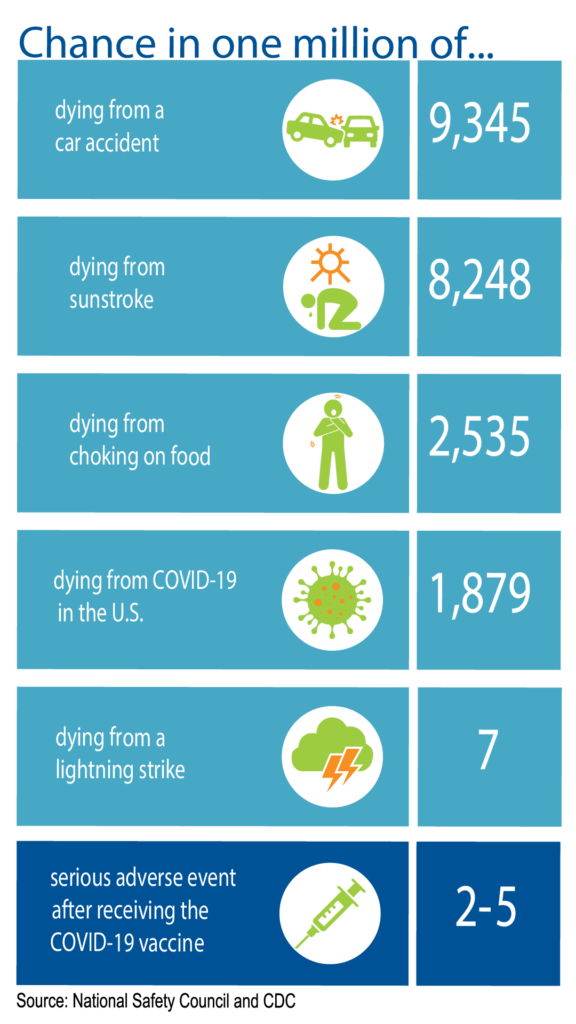The evidence is clear, but fear is powerful.
Studies show that fear is an important motivator in our behavior. We are much more likely to do (or not do) something if we fear it.
Figuring out how risky something is not easy for most of us. And generally, we don’t get it right. We worry about things we fear, even if they are unlikely to happen, and underestimate the risk of things we should be worried about because they don’t seem as scary to us.
And here, risk perception plays into vaccine hesitancy. Risk perception should be our ally. After all the evidence is clear, the risks associated with a disease are FAR greater than the risks associated with a vaccine.

We're terrible at understanding risk.
But the problem is that we’re terrible at understanding risk. Not just with vaccines. In general, we’re just really bad at determining what’s a real risk and what isn’t Don’t believe us, take a look at the figure above: people are far more concerned about a terrorist attack than a traffic accident. Yet we are significantly more likely to be injured in a traffic accident than be a victim of a terrorist attack.
The reason we get risk perception so wrong is that a lot of factors contribute to how risky we think something is. It depends on how the media covers something, our moods, and even our personality traits.
Cognitive Factors
Gravity of events
Media coverage
Risk-mitigating measures
Affective Factors
Emotions
Feelings
Moods
Contextual Factors
Framing risk of information
Availability of alternative info sources
Individual Factors
Personality traits
Previous experiences
Demographics
We overestimate concern about vaccines, and underestimate the risk of the illnesses they prevent.
What we do know is that many of us overestimate the risk of vaccines and underestimate the risk of the disease they prevent. Just as an example, many of us were really concerned about the J&J COVID-19 vaccine causing a blood clot. Some were so concerned that they chose not to get the vaccine.
But really, the risk of a blood clot after getting the J&J vaccine is only 0.0000088%. What does that mean in the real world? It means that you’re more likely to be hit by a plane while sitting in your own home than getting a
blood clot after getting the J&J vaccine.
You know what is risky? COVID-19.
If you’re worried about blood clots, 31% of people who get severe COVID-19 will develop blood clots. So out of every 1.1 million people who get the J&J vaccine, one will get a blood clot. Out of every 1.1 million people who get severe COVID-19, 340,000 will develop a blood clot.
The greater risk is with the disease, not with the vaccine.
So how do we help people better understand risk?
Here are three ways that can help.
 Compare the risk to something people think is unlikely, to help them understand the real risk. For example, the odds of being struck by lightning are one in 3,000 but the odds of a severe adverse event after vaccination are one in 1,000,000. Most of us don’t worry about being struck by lightning so it doesn’t make sense to worry about something that is significantly less likely to happen.
Compare the risk to something people think is unlikely, to help them understand the real risk. For example, the odds of being struck by lightning are one in 3,000 but the odds of a severe adverse event after vaccination are one in 1,000,000. Most of us don’t worry about being struck by lightning so it doesn’t make sense to worry about something that is significantly less likely to happen.
 Help people understand the risk of vaccinating and NOT vaccinating. The risk of complications from a disease are always greater than the risk of an adverse event due to vaccination. This is actually built into the vaccine approval process. In order for a vaccine to be approved, the benefits of a vaccine MUST outweigh any potential risks.
Help people understand the risk of vaccinating and NOT vaccinating. The risk of complications from a disease are always greater than the risk of an adverse event due to vaccination. This is actually built into the vaccine approval process. In order for a vaccine to be approved, the benefits of a vaccine MUST outweigh any potential risks.
For example, 9 out of 10 unimmunized people exposed to measles will get measles. 1 out of every 200 children with measles will develop pneumonia. And 1 out of every 1,000 children with measles will develop encephalitis. But only 1 out of every million doses of measles vaccine will result in a severe adverse event.
 Help people reframe their fears. Remember fear is a big contributor to how risky we think something is. So when talking with someone who is fearful of the vaccine, explain why you are more fearful about the disease.
Help people reframe their fears. Remember fear is a big contributor to how risky we think something is. So when talking with someone who is fearful of the vaccine, explain why you are more fearful about the disease.
Scared of “vaccine injury”? Share the very real and far more likely risk of disease injury. For example, the risk of a vaccine-related adverse event is 1 in 1 million. The risk of dying from Tetanus is 30%. So if one million unvaccinated people got Tetanus, 300,000 would die. But if one million people were vaccinated against Tetanus, one would get a serious adverse event.
Scared of the “unknowns” around vaccine? There is a pervasive piece of disinformation that floats around the vaccine-hesitant community, and it’s that the “science is not settled” on vaccines yet.
If that were true, it would be super scary. But the reality is that we have more than a century of vaccine research under our belts. The science is settled! And because of the thousands of studies, involving millions and millions of people, we know vaccines are a safe and effective way to protect us from deadly diseases.
What is unknown? The long-term effects of some of the emerging diseases like COVID. A year into the COVID pandemic, scientists were still discovering really alarming things, like that about a third of COVID survivors had some sort of brain injury. Fear the disease, not the well-researched vaccine that can prevent it.
The science is settled!
Don’t let anyone misrepresent the facts to you…
- Vaccines have been researched for MORE THAN A CENTURY
- BILLIONS of children have safely received vaccines
- Vaccine preventable diseases are controlled BY VACCINES

© Voices for Vaccines. Excerpts and links may be used by websites and blogs, provided that full and clear credit is given to Voices for Vaccines, with appropriate and specific direction and links to the original content. Parents, providers, advocates, and others may download and duplicate toolkits in print, without alteration, for non-commercial use and with full and proper attribution only.
